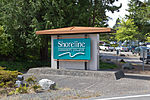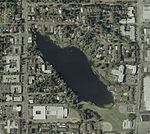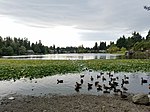Seattle Golf Club

The Seattle Golf Club (SGC; until November 2, 1912 Seattle Golf and Country Club or SCC) occupies about 150 acres (61 ha) in Shoreline, Washington, immediately north of Seattle. Although accounts disagree, Lou Gellos's history of the club confidently states that the 18-hole golf course was originally designed by Minneapolis-based Scottish golf course designer John Ball. It was most recently redesigned in 1996 by Arnold Palmer. The golf course and clubhouse (built in 1908, designed by Cutter & Malmgren) were developed in conjunction with The Highlands, an adjacent residential development. The club had purchased 380 acres (150 ha), and the portion not used for the course was divided into fifty parcels of land, all of which were initially sold to members of the club; those fifty parcels constitute The Highlands. Membership can be obtained only by invitation "through the sponsorship of Active members."While the club always has been, and remains, specifically a men's club, many women also play the course. In the early years, about twenty wives of members played; they paid dues under a status of Lady Golfers. In 1975, longstanding practice was formalized and any wife of a member was welcome to join as a Lady Golfer without a separate process of application. A women's locker facility was added when the clubhouse was remodeled in the 1980s.
Excerpt from the Wikipedia article Seattle Golf Club (License: CC BY-SA 3.0, Authors, Images).Seattle Golf Club
Boundary Lane,
Geographical coordinates (GPS) Address External links Nearby Places Show on map
Geographical coordinates (GPS)
| Latitude | Longitude |
|---|---|
| N 47.738 ° | E -122.36 ° |
Address
Seattle Golf Club
Boundary Lane
98177
Washington, United States
Open on Google Maps






